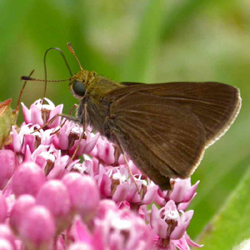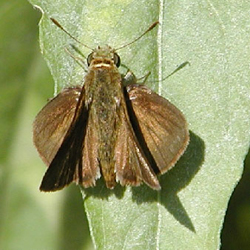Butterfly Atlas
Find a Butterfly
Dun Skipper
Euphyes vestris
Named
Boisduval, 1852

Taxonomy & Nomenclature
Widely referred to in the literature as Atrytone ruricola. The subspecific name metacomet (Harris), 1862, referring to the eastern race, is often appended to either species name.
Identification
Wingspan: 1 - 1 1/4". The male of this species is the region‘s most uniformly colored, small, dark skipper, normally with no pale markings on the wings above and at most traces of a pattern below. Males bear an obscure black stigmal slash on the forewing above. Pale markings on the wings of the female are relatively few and small compared to other "black witches". The largest spot at the center of the wing tends to be taller than wide with a rounded inner margin and concave outer margin, i.e. an outward-facing crescent.
Distribution
Transcontinental in North America from southern British Columbia to Nova Scotia south to northern Mexico and Florida (absent from the tropical extremity of the Florida peninsula). Widespread throughout New England. Scudder (1889) noted that it was "rarely (recorded) in the northern half", but that it was common at least as far north as Portland, Maine.
Status in Massachusetts
Generally common to abundant including at the highest elevations in appropriate habitat. However, apparently less common on the outer Cape Cod and relatively scarce on Cape Ann (fide Holmes and Leahy, pers. comm.). Also apparently less common during the MBAP period on Nantucket, where Scudder (1889) recorded it as "abundant" and Kimball (1943) considered it "general and common" and on Martha‘s Vineyard where Jones found it generally distributed and "sometimes in swarms." Maximum: 44 at Prescott (Worcester Co.), 10 July 1994.

Flight Period in Massachusetts
Mainly July and August, peaking between the midpoints of these months. Extreme Dates: 22 June (Scudder, 1889; no details); 5 July - several records on this date all in 1987 and all from central or western Mass.; 4 September 1995, Chilmark, Martha’s Vineyard (Dukes Co.), A. Keith.
Larval Food Plants
Probably sedges exclusively. Known to eat Nut Sedge (Cyperus esculentus) in captivity (Heitzman, 1964) and at least four species of Carex in the West, one of which, C. lacustris, occurs in New England. Sedge species preferred in the wild in New England have yet to be determined. Shapiro (1966) reports grasses, specifically Tridens flavus as host plants, but this has been widely doubted.
Adult Food sources
Recorded nectaring on 27 species of wildflowers during the Atlas period; also recorded on dung and at mud puddles. Scudder‘s assertion (1889) that the species "is particularly attracted by the flowers of mint, Fireweed (Epilobium angustifolium) and Indian Hemp (i.e. dogbane - Apocynum, spp.)" has been repeated frequently.

Habitat
Associated with wetlands and wetland edges. This is consistent with the prevalence of sedges, the species‘ preferred food plants, in such places. Moves readily to adjacent uplands, including disturbed areas and successional habitats such as roadsides and utility corridors, where nectaring plants are common. Some authors suggest an affinity with (deciduous) forest edges. Scott (1986) notes a preference for gullies and swales as perching sites for males awaiting females.
Life Cycle
The life history in the wild and the ecology of this species still lack many details. EGG: Pale yellow-green becoming partly reddish; a hemispherical dome, "the entire surface covered with a fine tracery of exceedingly delicate raised lines, forming polygonal cells" (Scudder, 1889; but he expresses doubt that this is the right egg!?); the surface covered with tiny punctures. OVIPOSITION: Eggs are laid singly on the leaves of the food plant. LARVA: Pale yellowish green with an "overcast" of white -- feeds in a rolled and/or tied leaf which it lines with its silk. CHRYSALIS: Yellowish to whitish green and covered with hair. PUPATION: Within the leaf roll nest at the base of the food plant. OVERWINTERING STAGE: Third instar larva.
Account Author
Chris Leahy



